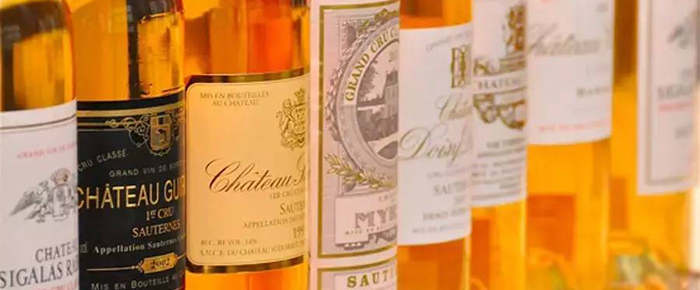
By Rick Riozza
Sauternes, a French term pronounced saw-turn even with the “s” at the end, might be the most expensive dessert you’ll ever order. Wine enthusiasts, including myself, will describe this wine with non-wine adjectives such as “heavenly”, “blissful”, “sublime”, “idyllic”—you get the gist.
After returning from France, Thomas Jefferson shared a bottle of Yquem sauternes with President George Washington who thereafter ordered 30 bottles. Château d’Yquem still produces the wine and is still considered the best dessert wine in the world.
Well—the consensus surely rates Yquem [EE-kem] as the best Bordeaux dessert wine. The real wine world will never discount or quantify the best classic dessert wines on earth, the similarly sumptuous nectars: namely, beerenauslese riesling, Tokaji Aszu, Coteaux du Layon from the Loire or even fortified examples like port and malmsey Madeira.
But Sauternes is an amazing quaff. I’ve enjoyed many a time offering a glass of Yquem to those who’ve never savored it, and thereafter, watch and listen to their culinary response. And “culinary” is the right word to use here as the wine is a momentous flavor experience—any foodie will assent to that, even those who don’t drink much at all. (Do note: that fractious group who assert to “never touch!/drink white wine, are surely staunch in their position: I don’t think I’ve ever persuaded even one to taste Sauternes—even after all of my rants and raves, their loss!)
For you wine geeks, Sauternes is an Old World wine, so it’s named after its area of origin. Sauternes is comprised of Sémillon, Sauvignon Blanc, and Muscadelle grapes. The Sauternais region of the Graves area in Bordeaux is “heavenly” situated, meaning, the contours of the rivers and slopes work a morning mist and a mini-climate where Sauternes is grown that causes the Sémillon grape to rot, allowing the benevolent fungus to do its magic. I’ve seen this up-close and it looks like the grapes are sick, shriveled, and desiccated with full-on leprosy.
Who on earth would ever consider making a wine from these grapes. Maybe someone already drunk who ventured to taste the seepage of black rotten grapes—yuck! But God loves to play counterintuitive with his people, and this “Noble rot” goes to make one of the lushest, luscious, and most delectable sweet wine available.
So just how does Sauternes taste? Well—like heaven! Expect Sauternes to exhibit intense notes of honeyed apricot, butterscotch, caramel, coconut, mango, ginger, marmalade, and panoply of citrus themes, along with tropical fruit, honeysuckle, and toasted baking spices. The key here is that the wine is not cloying: it’s full sweetness is balanced with an underline of acidity that keeps the flavors fresh. Present also can be a nutty and a touch musky flavor that gives way to a finish that lasts for up to a few minutes. Words can probably fail here, that’s why the wine needs to be tasted to experience that je ne sais quoi taste & feel. Though large bottles are produced, Sauternes is typically sold in half-sizes, of 375 ml.
My son Paolo recently grabbed a couple of 375 ml. bottles from his great stash of wine held at the Wine Vault of the Desert in Palm Desert. We decided to treat the table with a 2001 Rabaud Promise Sauternes. As with other great Bordeaux, there are vintages better than others. And then there are great vintages: 2001 being one of them. The conditions in producing the perfect Noble rot that year was stellar, making wines of fantastic flavor, complexity, and age ability.
After a “Bordeaux” themed dinner, we enjoyed the Rabaud by itself for dessert. Although medium-bodied, it was rich with orange and orange syrup notes, good acidity, honey, floral, toffee, and spicy palate. Served at around 57 degrees, as it warmed in the glass it developed more aromatic complexities with a varied marmalade profile. It was more on the savory side and less on the sweet.
Although this wine pairs wonderfully with very sweet desserts, it’s almost kind of overkill to do so when the wine itself is sweet enough. Consider cheesecake of all kinds, almond tart, lemon tart, meringues, and custards. That said, Sauternes really shines alongside something more savory such as Roquefort & fresh goat cheese. Foie gras is a perfect pairing with its natural sweet, salty and savory characteristics this all creates a beautiful balance on the tongue.
Pairing it with seafood dishes, especially shellfish, lobster, crab and oysters on the half shell, sushi or sashimi works great. Also it’s wonderful with herb-roasted chicken & poultry, and with veal & pork dishes that are either spicy, or prepared with a touch of sweetness. It’s a sexy choice with spicy Asian cuisine, where the sweet tames the heat. And, latkes and Sauternes is a perfect Hanukkah match of savory and sweet.
In Bordeaux, Sauternes is often recommended with lobster: sauté medallions of lobster with shallots, and deglaze the skillet with Sauternes. Drizzle the deglazed pan juices over the lobster, and drink the Sauternes with glee as you eat it.
As your local wine steward and somm-about-town, I’ve noticed that few seem to buy and/or drink much Sauternes anymore. Sauternes has been victimized by the trending sweet moscato-type quaffers. Once, sweet wines like Sauternes, the product of arduous labor, meticulous care and the luck of the vintage, were venerated as an ultimate pleasure. Their place on the table was evidence of great good fortune and perhaps a heightened perception of the sweetness of life.
C’est la vie—Cheers!











































